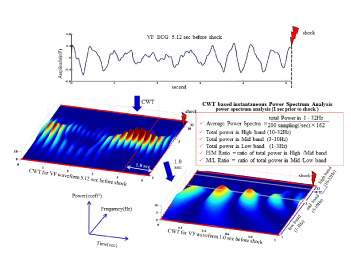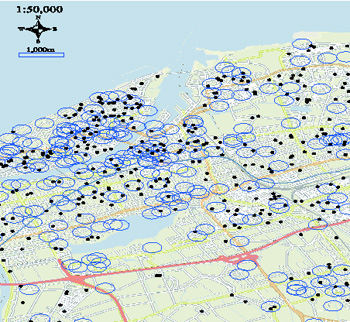1.Research Summary
The Department of Emergency and Critical Care Medicine conducts frequency
and complexity analyses, etc. to examine the relationship between waveform
data and severity/outcome, etc. using biosignal data that are automatically
saved in the biological information control system installed at our department
in Niigata University Hospital (approved by the ethics board).
We also conduct investigations to promote efficient and proper ambulance
transport system using the geographic information system (GIS) in collaboration
with the Niigata City Fire Headquarters (approved by the personal information
protection committee of Niigata City).
2.Research Area and Subjects
(1)Research on biosignal analysis
(2)Research using the GIS
3.Research Results
[Area] Research on biosignal analysis
[Research subject]
Waveform data analysis, “Prediction of successful or failed defibrillation based on one-second ventricular fibrillation waveform”
[Description]
If successful or failed defibrillation can be predicted before electrical
defibrillation in cardiac arrest patients, wasteful interruption of heart
massage can be avoided. We, therefore, examined whether or not successful
or failed defibrillation could be predicted based on the ventricular fibrillation
(VF) waveform in 5.12-second and 1-second segments immediately before defibrillation.
Total energy in the low- (1 to 3 Hz), intermediate- (3 to 10 Hz) or high-k
(10 to 32 Hz) band of the VF waveform was calculated by the continuous
wavelet transform (CWT) technique. Frequency and complexity analyses were
performed for the VF waveform in a 5.12-second segment. Logistic analysis
revealed that the total energy of the central frequency of the VF waveform
in a 5.12-second segment and the intermediate band of the VF waveform in
a 1-second segment were significant predictors. The upper figure shows
a VF waveform in a 5.12-second segment. The middle figure shows CWT frequency.
The lower figure shows the frequency transform of a one-second segment.
J Anesth. 2011 ;25(1):34-41
[Photographs]

[Area] Research using the GIS
[Research subject]
Research on installation of AEDs, “Simulation when AEDs are installed at convenience stores and security offices”
[Description]
Seventy percent of sudden cardiac arrest (SCA) events occur at home and
are usually not subject to a public access to defibrillation (PAD) program.
Therefore, a simulation when AEDs are installed at convenience stores and
security offices (325 places in total), where AEDs are accessible anytime
24 hours a day, in Niigata City, was conducted using the GIS. As a result,
it was estimated that the number of AEDs deployed might be 57% of the currently
available number, the incidences of SCA at home might be 16.5% and 5.7%
within 200 meters and 100 meters, respectively, and the incidences of SCA
at home and witnessed might be 17.8% and 5.1%, respectively. Convenience
stores and security offices were shown to be effective places for deploying
AEDs for SCA at home. The figure shows places where AEDs are deployed within
200 meters and SCA at home.
Journal of Japanese Association for Acute Medicine. 2011; 15 (1): 1-6.
[Photographs]

